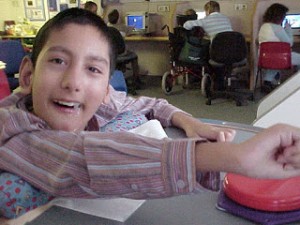Busted: Developing Switch Timing Skills

When someone is learning to scan using one switch there are two key skills that they need to practice. The first is the ‘timing’ skill. This involves the student pressing the switch in response to some cue often something popping up on the screen. In the Switch Progression Road Map, it’s described as;
20: Student can press a single switch in response to an on-screen cue.
The most common way to teach this skill has always been with software. You know the thing. A car pops up on the screen and the student hits the switch when they see it. If the student manages to press the switch before the car disappears, they are rewarded with a short animation. Sounds easy and for some of our students it is.



